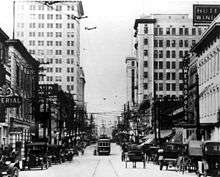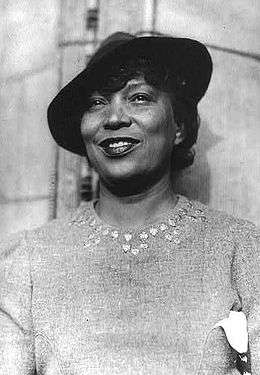How It Feels To Be Colored Me
"How It Feels To Be Colored Me" (1928) is an essay by Zora Neale Hurston published in World Tomorrow as a "white journal sympathetic to Harlem Renaissance writers",[1] illustrating her circumstance as an African American woman in the early 20th century in America. Most of Hurston's work involved her "Negro" characterization that were so true to reality, that she was known as an excellent anthropologist, "As an anthropologist and as an African-American writer during the Harlem Renaissance, Hurston was uniquely situated to explore the critical possibilities of marginality."[2][3]
Coming from an all- black community in Eatonville, Florida, she lived comfortably due to her father holding high titles, John Hurston was a local Baptist preacher and the mayor of Eatonville. After the death of her mother in 1904, at the age of nine years old, Hurston was forced to live with relatives in Jacksonville who worked as domestic servants. In her essay Hurston references Jacksonville where she describes that she felt "thrown against a sharp white background". Eatonville and Jacksonville became the main influential settings for her essay "How it Feels To Be Colored Me" and her novel Their Eyes Were Watching God. In both writings Hurston begins to investigate the true meaning of individuality and personality, through the usage of anecdotes, imagery, tone, and figurative language. Hurston's writings allow the reader to understand "personal expression to the arena of public discourse without losing the ties to their home cultures and languages"[4]
Plot summary

Hurston begins the essay about her childhood in the town of Eatonville, Florida, where Hurston is the main character. Hurston describes how she sits on her front porch and her satisfaction of watching white people pass through her town. She greets her neighbors, dances and sings for the visiting white people knowing that if one of her family members would see her she would get into trouble. In return she receives money. Hurston becomes comfortable with her surroundings in the small town of Eatonville. At the age of thirteen her mother passes away and Hurston was sent away to leave her home in Jacksonville to attend a boarding school. At this point, Hurston is referred to as just another “colored girl.”[2] She then elaborates how Eatonville was a safe zone for her since it was considered a “colored town”[2](358). As time progressed, she realized the difference between herself and others surroundings:like her skin and the different personality in her friends. She begins to feel a sense of isolation and loneliness. Although, Hurston claims that she does not consider herself “tragically colored” but a regular human being, “At times I have no race, I am me”[2](359). She mentions her experience at a jazz club with a white friend, where through the music she expresses the racial difference and distance between their lives. She concludes her essay acknowledging the difference but refuses the idea of separation. “I have no separate feeling about being an American citizen and colored”[2] (360). She explains that if the racial roles were reversed, and blacks discriminated against whites, the outcome is the same for a white person’s experience amongst black people. In her final paragraph, she compares herself to a brown paper bag filled with random bits, just as everyone around her is a different colored paper bag filled with small bits and pieces that make each unique. Hurston concludes that every race is essential and special to the “Great Stuffer of Bags.”[2] She encourages one not to focus on race, but one’s self-awareness and the similarities we all have in common.
Historical background
Hurston has written plays, essays, poetry, short stories, and novels with an emphasis on folkloric foundation. She graduated from Columbia University as an anthropologist. Some scholars claim “Hurston belonged to the Depression-era group of black writers that also included Ralph Ellison and Richard Wright”.[5] Similarly, to other black writers in this era, Hurston used her writings to expose the living conditions of black people, not only to black readers, but white readers. Although, Wright criticized Hurston for falsifying information and the perspective of black living even though Hurston presented social problems in her writing. Hurston and Wright both wrote about the importance of self-identity. Hurston’s work writings emerge from “dislocation and disorientation.”[5] Hurston’s writing is known to have boldness with “heavy black English dialect.”[5] Although, some scholars debate whether Hurston’s work is true Harlem Renaissance writing. Margaret Perry’s survey of all literature in the Harlem Renaissance, suggests “Hurston should not be included in the literary canon of the Harlem Renaissance because the bulk of her work appeared after the ‘true time of the Harlem Renaissance’ a period in the years 1925 to 1928.”[6] (Musser 28) Alice Walker was one of many who rediscovered Zora Neale Hurston. Walker had become interested in Hurston’s works and wrote I Love Myself When I Am Laughing… And Then Again When I Am Looking Mean and Impressive: A Zora Neale Hurston Reader in 1979. Similar to Hurston’s parallelism of life and her life in “How It Feels To Be Colored Me”, Walker’s writings were influenced by her own experiences. Walker not only rediscovered Hurston’s works, but revisited the era of the Harlem Renaissance. She placed a huge emphasis towards why the Harlem Renaissance writings were essential and lead the continuation of scholarship and publication of Hurston’s works after 1970.
“How It Feels To Be Colored Me” is an essential essay which is linked to the studies of African Literature, Feminist Literature, and African American Studies. Hurston’s essay also reveals her perspective of racial segregation through the usage of anecdotes, imagery, tone, and figurative speech. In the end she concludes we are all one race regardless of color.
References
- ↑ Johnson, Barbara (1985). "Thresholds of Difference: Structures of Address in Zora Neale Hurston". Critical Inquiry. 12: 278–289. JSTOR 1343471.
- 1 2 3 4 5 6 Gilbert and Gubar, Sandra and Susan (2007). The Norton Anthology of Literature by Women. The Traditions in English: Early Twentieth Century through Contemporary. New York: W.W. Norton & Co. pp. 358–361.
- ↑ Wald, Priscilla (1990). "Becoming Colored: The Self- Authorized Language of Difference in Zora Neale Hurston". American Literary History. 2: 79–100. JSTOR 489811.
- ↑ Heard, Matthew (Winter 2007). "Dancing is Dancing No Matter Who is Doing it: Zora Neale Hurston, literacy, and Contemporary Writing Pedagogy". Project Muse. 34: 129–155.
- 1 2 3 "Hurston , Zora Neale | Encyclopedia of Women's Autobiography. Credo Reference". search.credoreference.com. Retrieved 2018-01-28.
- ↑ Musser, Judith (1998). "African American Women's Short Stories in the Harlem Renaissance: Bridging a Tradition". MELUS. 23: 27–47.
